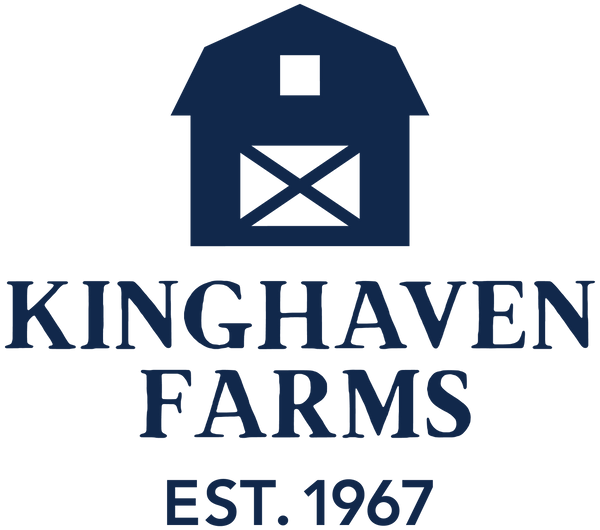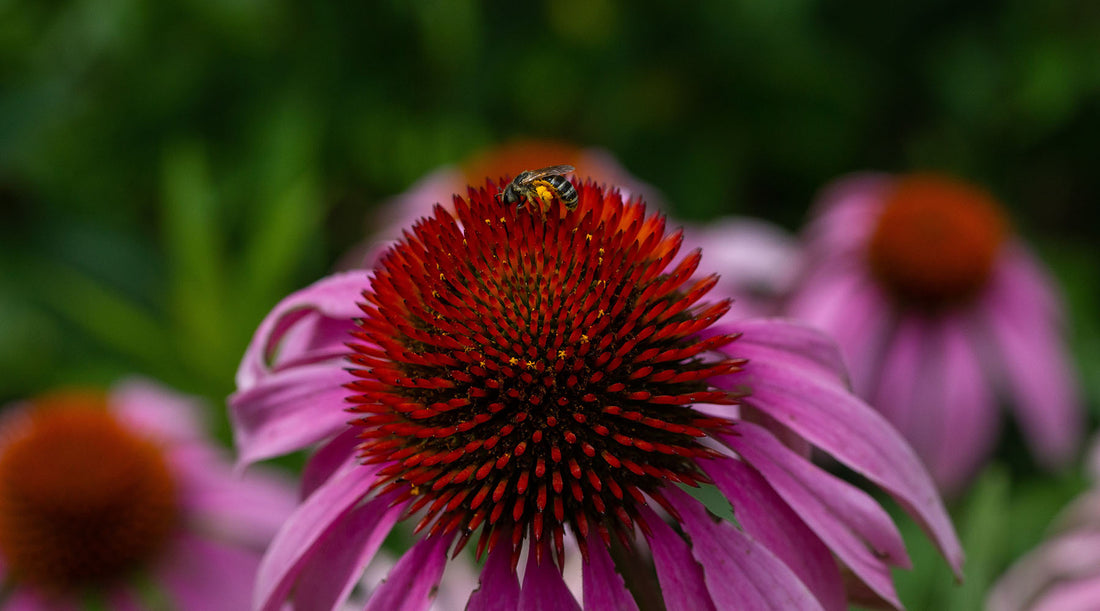Without bees, your dinner plate would look a lot barer. As pollinators, bees play a huge role in what you consume, far beyond the honey they produce. Ontario’s more than 400 species of bees aren’t the only pollinators out there, however.
Birds, flies, wasps, butterflies, moths, and even beetles play a crucial and irreplaceable role in the food system. But, pollinators are facing some substantial challenges at the moment. Here’s how pollinators affect the environment, and what you can do to help support them.
What is pollination?
Like all living things, plants reproduce — a subset of them can even do it asexually by cloning themselves. Many of the foods humans eat, however, depend on plants that reproduce sexually. While this might conjure up some weird images, it simply means that these plants have a female part (the stigma) that requires fertilization by pollen from their male part (the anther) to create offspring.
Plants, of course, cannot easily travel from one place to another. So, to bridge the gap between their female and male parts they employ a couple of different strategies.
Wind-pollinated plants like wheat and ragweed release huge amounts of tiny pollen grains, harnessing wind power to propagate their species. As a side note, this is also why your allergies go nuts the minute ragweed season starts.
Alternatively, plants attract pollinators as their agents of reproduction. To do this, they produce nectar — an irresistibly sweet food that’s also a great source of energy.
As the pollinator lands on the flower to drink the nectar, pollen from the male part of the flower — the anther — transfers to their body. And, when they move on to the next flower, some of those grains fall off, fertilizing the female portion — the stigma — of this flower.
It’s estimated that about one-third of the food on your plate depends on honey bees for pollination.
What is a pollinator?
Any creature that helps to fertilize a plant is considered a pollinator. Honey bees are probably the most famous, but a number of other animals also fill this role. These include wasps, flies, butterflies, birds, moths, beetles, bats, and even mosquitoes.
Which food crops require pollination?
Staples like oats, wheat, and rice are the building blocks of global food production, making up the bulk of many people’s diets. They’re also wind-pollinated and don’t require pollinators. Most of the other crops humans eat, however, do.
Almost every variety of fruit requires pollination, as do many nuts and seeds like almonds, sunflower seeds, and cashews. Others, such as sesame, are wind pollinated, but see an additional benefit from pollination by bees and other insects.
Many of your favourite vegetables also depend on bees and other pollinators — beans, brussel sprouts, cauliflower, cucumber, and zucchini are just a few.
Fruits and veggies aren’t the only pollinator-dependent heavy hitters — cocoa trees require tiny visitors to reproduce as well.
And, while some varieties of coffee plants are self-pollinating, bees and other pollinators still have immense benefit to the plant. Pollination from bees and other insects improves not only the coffee crop yield, but also the size and the quality of the beans the plants produce. And, certain varieties are entirely dependent on pollinators.
The benefits aren’t limited to food crops either. Although cotton is technically self-pollinating, it relies on additional help from bees and other insects to increase its yields. A world without pollinators would likely mean a lot more polyester.
What happens if pollination doesn't occur?
Many plants can’t reproduce if pollination doesn’t occur. Although they will continue to flower, they won’t be able to bear fruit or produce seeds. Apple trees, for example, don’t grow apples when they go unpollinated.
Self-pollinating plants such as strawberries need additional help to produce the best berries. When bees and other insects don’t visit them, strawberries don’t form properly, and they tend to be smaller, and less plentiful.
The same goes for coffee. Despite being self-pollinating or wind-pollinated, many coffee varieties achieve superior yields and better beans with the help of bees and other pollinators. Without pollination, coffee lovers would have fewer varieties to choose from and lower quality beans. You’d also likely find yourself paying more for your morning cuppa since producers would experience a less bountiful harvest.
Human food systems aren’t the only ones that depend on pollination. Non-domesticated plants like wild blueberries and alfalfa rely on bees and insects to help propagate themselves. By extension, this makes the animals that feed on these native species like deer, mice, and rabbits, reliant on them too.
How do honeybees fit in?

Pollination isn’t the exclusive domain of honeybees. Some birds and a number of different insects including moths, flies, butterflies, wasps, and beetles are all involved in pollination. But honey bees punch well above their weight, making it hard to dispute their position at the top of the pollinator hierarchy.
Just how important are honey bees? It’s estimated that about one third of the food on your plate depends on honey bees for pollination. In financial figures, that’s about five and a half billion dollars a year in Canada alone.
Bees are so vital to our survival that they’re considered a keystone species. Remove them from the ecosystem, and the whole thing comes toppling down.
How do flowers affect the taste of honey?
Bees don’t pollinate out of the goodness of their hearts. Instead, bees and flowers have evolved together over millions of years, making plant reproduction a byproduct of the bee’s search for nectar. And, as the main ingredient of the golden superfood they produce, nectar plays a leading role in how honey tastes.
Like wine, each honey has an individual flavour profile, or terroir, based on where and what time of the year it’s made. Some specialty producers opt for single-varietal honeys like Manuka, orange blossom, or lavender. Most honeys available in Ontario, however, are multi-flower varietals, which gives them a full, floral flavour.
Whichever variety of honey you like best, if you’re intent on tasting the unique bouquet of your honey, look for the term “raw” on the label. This means the honey hasn’t been pasteurized, a process that removes much of its unique flavour and nutritional benefits.
What are the biggest threats to pollinators?
As urban centres spread and wilderness is converted into agricultural land, the wild plants and flowers pollinators rely on are lost. Bees can travel as far as 12km to find food, but they prefer to visit flowers much closer to their hive. If their immediate surroundings are asphalt roads and concrete towers, it’s very difficult for them to find the nutritional resources they need to survive.
But, habitat loss isn’t the only major threat to their survival. Large-scale agricultural operations and the pesticides they use — particularly a category known as neonicotinoids — are disastrous for pollinators. Unfortunately, plants absorb these neonicotinoids and they end up in their nectar and pollen. They also leech into the soil, contaminating anything that’s planted nearby.
And, while these pesticides keep pests like aphids away, they also affect pollinators. Even low level exposure to these pesticides is toxic. In bees, it influences their neuronal function, causing seizures and impacting the way they learn. This, in turn, affects their ability to navigate and reproduce.
Climate change and pathogens also have significant impacts on pollinator populations worldwide. As extreme weather events increase and seasonal norms change, pollinators have a harder time finding food, knowing when to migrate, and dealing with increasingly extreme temperatures.
All of these issues contribute to stressing pollinator populations which, in turn, makes them more susceptible to pathogens and parasites.
Five ways to support pollinators with your fall gardening
Current threats facing pollinators can leave you feeling disheartened. But, there are simple things you can do to help. Here’s how:
1. Leave your leaves. Good news if you hate raking! Leaving your leaves on the ground doesn’t just shorten your to-do list, it also provides an overwintering habitat for tiny, beneficial critters like butterflies and beetles. Increase the benefits by mounding the leaves around garden plants. This adds valuable nutrients to the soil while simultaneously helping to insulate your plants against winter’s chill.
2. Plant your spring bulbs. Daffodils, tulips, and crocuses are among spring’s most cheerful first signs. Find a sunny spot in your garden or lawn and tuck these bulbs into the warm earth before the ground hardens for winter. Your future self will thank you when these beauties emerge in the spring. Early bees and insects are sure to appreciate them too.
3. Plan your spring garden. Cities can be food desserts for pollinators, but even a few window boxes worth of flowers can make a difference. If you’ve been meaning to add a garden, now’s a great time to start planning. Consider adding flowers to your balcony or replacing your lawn with a variety of native flowering plants. Options like bee balm, echinacea, black-eyed susans, and lavender are wildly attractive to bees. Even better, they require very little maintenance and return annually.
4. Add late-flowering blooms to your garden. Cooler temperatures may be keeping you inside more, but pollinators are still out foraging for calories. Dahlias, goldenrod, and asters are just some of the hardy, late-season beauties that keep your garden full of colour while providing an important food source for local insects.
5. Don’t over-manicure your garden. Whether it’s a series of plants on your balcony, or a large suburban lot, the wilder your garden is, the more attractive it’ll be to tiny, beneficial visitors. Trade in excessive clearing, pruning, and raking for a good book and a cup of tea with creamed honey instead.
Bees and other pollinators are crucial to the ecological balance. Beyond your own backyard, consider supporting local farmers and honey producers.
Local producers help to maintain healthy pollinator and bee populations in your community while supplying you with incredible varieties of home-grown honey. And, seeking out producers that support sustainable practices will make where you shop matter just as much as what you eat.
Header Image: Alex Chiu Productions

